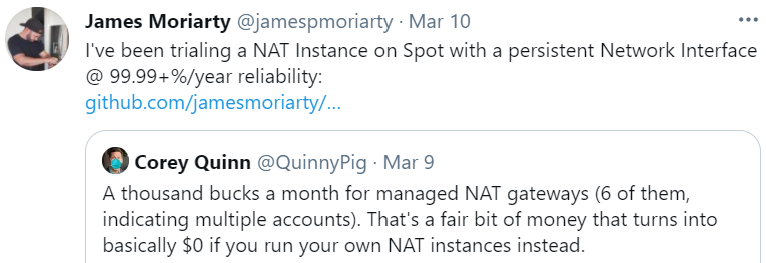AWS NAT Internet Egress
My work often involves restricted private networks often found in large enterprises. I run a personal similarly provisioned AWS VPC for experiments. This comes with the challenge of providing internet egress for RFC1918 private subnet instances.
AWS provides several solutions for internet egress. After spending some time considering these, I settled on NAT instance running on Spot. The primary driver of this solution is cost.
Caveats
The current solutions is:
- Auto Healing
- automatically replaces the unhealthy instance.
- re-attaches a persistent network interface to recover transport level details such as routes.
Is not:
- Highly Available
- instance unavailability will cause NAT disruption.
- Fault Tolerant
- the persistent network interface results in dependency on a single zone.
Reliability
| Risk | ETTD | ETTR | EETF | Impact | Notes |
|---|---|---|---|---|---|
| Spot Restart | 5m | 5m | 30 days | 100% | Every month** |
| EC2 Fails | 5m | 5m | 90 days | 100% | Every three months* |
| AZ Fails | 5m | 2h | 180 days | 100% | Every six months* |
| Region Fails | 5m | 4h | 730 days | 100% | Every two years* |
Looking specifically at Spot Restart:
43,200 = 60 min * 24 hours * 30 days (valid minutes)
10 = 5 ettr + 5 ettd (bad minutes)
99.98% = (valid - bad) / valid * 100 (fraction of good minutes)
That’s nearly four nines of reliability with the introduction of Spot. I’ve also used a generous minimum ETTD & ETTR despite the autoscale group generally recovering within two minutes.
* 90% SLA the SLO appears to be much higher.
** Based on uptime.
April 2, 2020 at 8:36:05 PM UTC+11 (1919 hours)
Cost
The following costs are an estimate:
| solution | network | cost/GB | cost/hour | cost/month |
|---|---|---|---|---|
| NAT Gateway | 5-45 Gbps | 0.059 | 0.059 | 42.48 |
| NAT Instance | 0-5 Gbps | 0-0.114 | 0.0059 | 4.25 |
| NAT Instance (spot) | 0-5 Gbps | 0-0.114 | 0.0018 | 1.30 |
Spot market costs are variable but current data suggests:
t3a.nano (1) … total 69% savings
Performance
The performance test can be reproduced with the following command:
yum install python python-pip -y \
&& pip install --upgrade pip \
&& pip install speedtest-cli \
&& speedtest-cli
The t3.nano instances provide several Gbps up and down.
Download: 3283.42 Mbit/s Upload: 2274.26 Mbit/s
Conclusion
This solution has proven acceptable for small egress bandwidth requirements in the range of 1-5 Gbps. The Github project can be found here.
